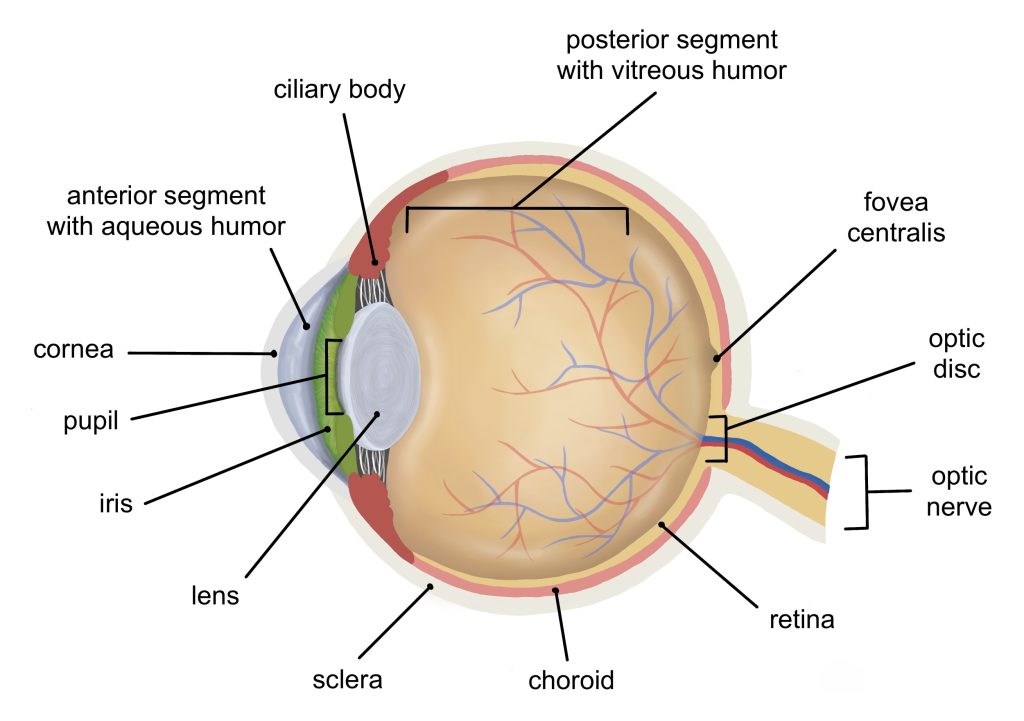The Eye
The eye is a spherical structure that focuses light so that it can be collected by sensory cells (photoreceptors) located on the eye’s posterior surface. Light travels through the cornea and pupil of the eye to the lens which helps focus the light onto the retina at the back of the eye. The wall of the eye is composed of three distinct layers. The white outer layer is the sclera, an avascular, fibrous layer of dense connective tissue that is often referred to as “the white of the eye”. The extrinsic muscles that move the eyeball are anchored to the sclera. The middle layer is called the choroid, a highly vascular and richly pigmented layer. The retina is the innermost layer and contains the photoreceptor cells and neurons. These sensory photoreceptor cells, rods and cones, capture light energy and convert it to a electrical signal that is transmitted to the central nervous system through the optic nerve (cranial nerve II).
The anterior portion of the eye contains specialized structures required for transmitting and focusing light (Figure 1). The anterior surface of the eye is a transparent region called the cornea that allows light to enter the eye. Branching off from the choroid is a ringed structure containing the iris (colored part of the eye) anteriorly and the ciliary body (that holds and controls the lens of the eye) posteriorly. The center of this ring is an opening called the pupil. The lens is a transparent flexible structure that plays a role in focusing the light on the retina. It divides the eye into two internal chambers filled with fluid. The space in front of the lens is the anterior segment and the space behind the lens is the posterior segment. The anterior segment is filled with aqueous humor (a clear fluid that helps transmit light and maintain the shape of the cornea).The posterior segment is filled with vitreous humor (a clear gel that helps transmit light and holds the retina in place).
Figure 1: sagittal section of the eye revealing internal gross anatomy

Figure 2 highlights the major layers of the wall of the eye:
- Sclera – outermost layer containing dense connective tissue
- Choroid – middle layer containing highly vascular and richly pigmented tissue
- Retina – innermost layer containing nervous tissue (photoreceptor cells and neurons)
Figure 2: Tissue layers of the wall of the eye with and without illustration overlay
the Retina
The retina contains 4 distinct layers of cells that act as a relay pathway to transmit sensory information from photoreceptors to the optic nerve. The cell layer of the retina closest to the choroid is a layer of pigmented epithelium. The dark pigment in this layer helps to absorb light. The epithelial cells help to structurally and functionally support the neural rod and cone cells in the next layer. The rod cells help with night vision and function in low light. The cone cells function in bright light to transmit high-resolution sensory visual input. The rod and cone cells contain photoreceptor proteins that can be excited by light energy. This sensory information is transmitted by the rod and cone cells to the middle neural layer of bipolar cells. The bipolar cells connect the rod and cone cells to the innermost layer of the retina, made up of ganglion cells. The axons of the ganglion cells run the length of the back of the eye to collectively become the optic nerve.
Figure 3: Cellular layers of the retina with and without illustration overlay
Chapter Illustrations By:
Juan Manuel Ramiro-Diaz, Ph.D.
Karis Le
